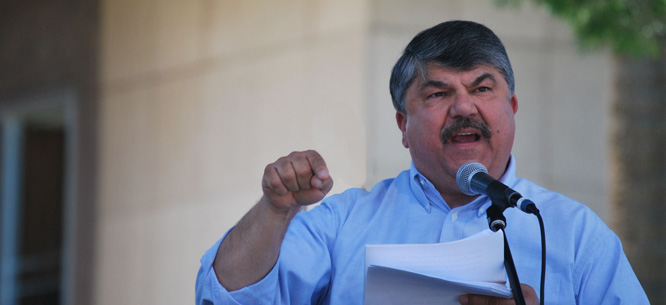Why Unions Win When They Win
Why Unions Win When They Win

Last week, newspapers and news sites splashed headlines announcing labor’s big victory blocking the Trans-Pacific Partnership, President Obama’s trade deal. It has been quite a while since words like win and labor appeared in the same headline. A few weeks back, even AFL-CIO leaders didn’t expect they and their progressive allies could derail the fast-track trade authority that the Democratic president, most Republicans in Congress, and nearly every big corporation in the land urgently sought.
But what did labor actually win? If the TPP bill does not pass, more manufacturing jobs will probably stay at home. Yet, by itself, that would do little to reverse the long decline of union membership in the private sector, which now stands at just above 6 percent. Few American employers are willing to sign a union contract when they can get away with offering lower wages and fewer benefits.
The hard struggle the AFL-CIO just spearheaded could become yet another example of a long, ironic tradition in labor politics: When union activists fight for issues that clearly affect large numbers of ordinary people, they often win. But when they try to persuade voters and legislators to defend or expand the membership of their own organizations, they usually lose.
Some of labor’s gains on larger issues occurred when the movement itself had few rights employers or the courts felt bound to respect. The movement’s earliest big triumph was one every good progressive would condemn today: a ban on the immigration of Chinese laborers that Congress passed in 1882. Fledging, white-only unions in the West led the campaign to enact a measure to protect their fellow “meat-eaters” from the competition of underpaid “rice-eaters” from East Asia.
Soon, labor had better causes to advocate. During the early twentieth century, unions represented less than 10 percent of American workers. But the AFL, led by Samuel Gompers, still managed to get Congress to make Labor Day a federal holiday, to lobby states and cities to enact workplace safety laws, and, in 1916, to secure an eight-hour day for railroad employees—then the most essential group of wage-earners in the nation. Even many lawmakers who disliked unions understood these measures had the support of most of their constituents.
But until the 1930s, unions failed to get Congress to enact laws to protect their organizers from being fired or boycotters from having to pay big fines for allegedly violating anti-trust laws. It was fairly easy for the National Association of Manufacturers and other employer groups to argue that unions existed only to protect the privileges of skilled workers and sometimes used coercion and violence to get their way.
But the Great Depression badly sullied the image of big business, and a wave of massive strikes by non-union workers in 1934 ushered in a great, if one-time, legislative victory. The Wagner Act, passed in 1935, set up the federal machinery that enabled millions of wage earners who wanted union recognition to achieve it. Franklin D. Roosevelt and his allies in Congress justified the Wagner Act as essential to boosting purchasing power, not as a step toward industrial democracy (which it was). But labor’s “Magna Carta” did help the AFL and the new CIO to quintuple their combined membership to 15 million by the end of the World War II.
The unprecedented surge did not, however, protect labor from the attacks of its powerful, pro-corporate adversaries. After the Republicans won control of Congress in 1946, they quickly enacted the Taft-Hartley law, which allowed states to pass “right-to-work” legislation and made a variety of union organizing tactics illegal. As labor’s numbers have dropped in recent decades, its officials have repeatedly tried and failed to persuade even Democratic presidents and legislators to shift the laws back in their favor or to enforce the Wagner Act with rigor. Despite its explicit provisions, thousands of workers get fired every year for trying to organize a union.
Yet labor activists still kept pushing for major reforms that did little or nothing to boost their own ranks. Most of the black men and women who organized the 1963 March on Washington for Jobs and Freedom were union activists. And AFL-CIO lobbyists made sure the Civil Rights Act of 1964 included Title VII—the landmark ban on employment discrimination. They were also a key part of the coalition that supported Medicare and Medicaid—and decades later, the Affordable Care Act.
More recently, at the urging of labor-heavy coalitions, Seattle, Los Angeles, and other big cities have enacted big boosts in the minimum wage. Around the country, the Service Employees International Union—the SEIU—has coordinated one-day strikes by fast-food workers demanding $15 an hour. These discontented burger-flippers may want to join a union, but there is scant pressure on McDonald’s franchises to recognize one.
Meanwhile, GOP legislators have passed “right-to-work” laws in Michigan and Wisconsin, imperiling existing unions in states where the power of the Teamsters and United Auto Workers once seemed impregnable. And without his union-busting triumphs, Wisconsin Gov. Scott Walker wouldn’t be a serious candidate for the Republican Party’s nomination. “Standing up to big labor” remains a winning strategy, even when unions represent just 11 percent of the public and private workforce and, in many places, are fighting to survive. In launching her campaign speech at Roosevelt Island last weekend, Hillary Clinton mentioned unions only twice, in passing. She said nothing about defending their right to organize.
“This is a significant day,” declared AFL-CIO president Rich Trumka, rather hyperbolically, after last week’s vote against the trade bill. “American workers came together and spoke with one voice about the path their country and economy should follow.” But unless the day arrives soon when those workers speak as loudly about their need for representation on the job, that path will resemble Walker’s Wisconsin more than Roosevelt’s America.
Michael Kazin is co-editor of Dissent.




